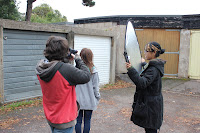For this attempt at filming we decided that we would need a wider variety of locations so we thought that we should expand on where it was that we would go to film, one group travelled around the local streets and roads by car gathering tracking shots and would later film in some back alleys and streets to give a variety of situations, while the other group would film in a specified area to perform sequences of shots that could provide some sense of narrative, while also experimenting with camera angles and light techniques.


These are a few of the locations that the 1st group in charge of gathering vehicle tracking shots filmed in to provide various shot types, this was to provide a sense of "realism" to the shots.

The group that focused on camera shot types, angles, sequencing and lighting was centred mainly on one street in the local area, Queens Road, Nuneaton where we gathered various shots and angles that could be used or sequencing. We later moved to the previously visited location of Abbey Theatre near High Street, where we chose to perform some sequencing shots and experiment with the light reflector to try and determine if it would improve our footage, we used the location for a number of shots such as the chance for close ups, long shots and cutaways of a subject. This location proved useful in previous shoots so we believed it would be a decent place to perform further experiments.
New Wave
The locations we visited during this shoot are relevant to a new wave film as they are local areas that add a sense of social realism to the film, and these locations show the type of area that we were filming in and can even show some problems that affect the area. New Wave films often use locations that reflect political or social issues that are either apparent or at leads hinted at in the film and we tried to do this by using locations that were in a local area, easily accessible and reflected some sort of social issue that could be highlighted in our films.
OH&S: Occupational Health and Safety
During this shoot we visited many areas of the local town which included some location seeing down back alleys and in isolated areas, there are many risks involved with areas such as these and before shooting we needed to assess the risks involved with the location.
- Risk of falling and causing injury to self or others
- Risk of damaging equipment
- Risk of harmful/unsanitary objects in the area e.g. broken glass
- Risk of being attacked/mugged
- Risk of equipment being stolen
These risks involving these areas could however be avoided by following simple measures against these risks including:
- Making sure that all equipment is carried properly and is kept in sight at all times
- Ensure that there are no objects/obstacles that could trip someone whilst filming
- Ensure that the crew stays in a drop and no member is on their own
- Ensuring that the area is surveyed before actually visiting the location to check area reputation, obstacles and how to travel through the area.























































